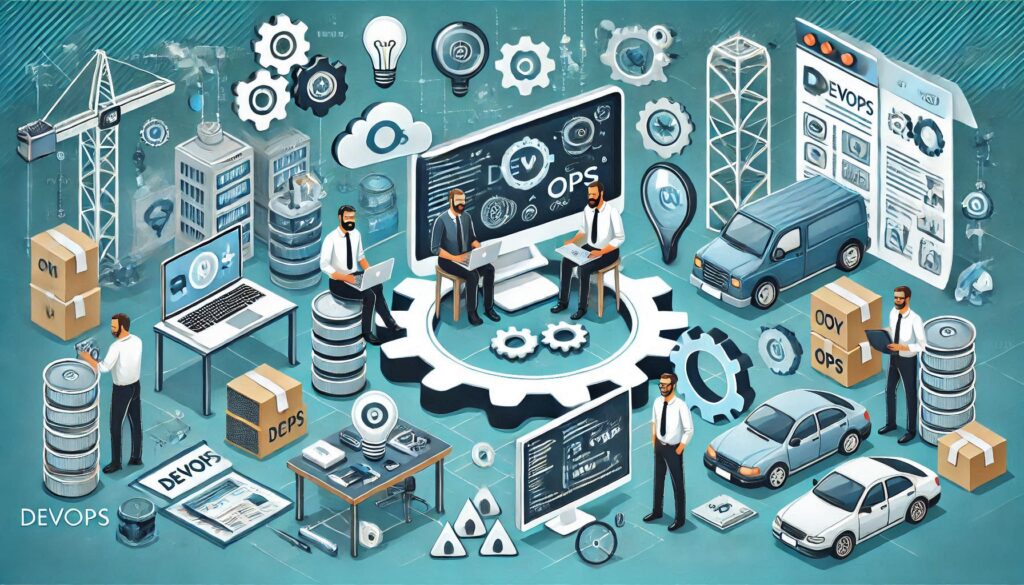The Role of DevOps in Modern Software Development: Modern DevOps Practices and DevOps Automation Tools

The Role of DevOps in Modern Software Development: Modern DevOps Practices and DevOps Automation Tools
The Role of DevOps in Modern Software Development: Modern DevOps Practices and DevOps Automation Tools: In the ever-evolving world of technology, software development stands at the forefront of innovation. With the increasing demand for rapid delivery, enhanced reliability, and efficient workflows, traditional methods of software creation have struggled to keep pace. Enter DevOps: a transformative approach that has redefined how we think about building, deploying, and maintaining software.
Modern DevOps practices are no longer just a buzzword. By integrating development and IT operations, DevOps fosters a culture of collaboration, speeds up software delivery, and ensures greater system reliability. This article delves into the nuances of DevOps culture, explores its principles like continuous integration and deployment, and highlights its impact on Agile DevOps software development, DevOps automation tools, and the broader software lifecycle.
The Essence of DevOps Culture
At its core, DevOps is more than a set of tools or practices; it is a culture. The term “DevOps” is a portmanteau of “development” and “operations,” but its implications go far beyond these domains. It represents a shift in mindset that prioritizes collaboration, shared responsibility, and continuous improvement.
Breaking Down Silos
Historically, development teams and operations teams operated in silos. Developers focused on creating features and functionalities, while operations ensured the infrastructure could support these features. This separation often led to miscommunication, delays, and a blame culture when things went wrong.
Modern DevOps practices foster a culture of collaboration by dissolving these silos. By fostering cross-functional teams where developers, operations personnel, and other stakeholders work together, DevOps ensures alignment of goals. The result? Faster decision-making, reduced friction, and a shared sense of ownership.
Key Pillars of DevOps Culture
- Collaboration: Open communication channels and shared objectives ensure that all team members are aligned.
- Automation: Mundane, repetitive tasks are automated using DevOps automation tools to reduce errors and free up resources for higher-value work.
- Continuous Learning: A culture of experimentation and feedback helps teams iterate and improve continuously.
- Customer-Centric Mindset: DevOps emphasizes delivering value to end-users quickly and efficiently.
Agile DevOps Software Development: A Perfect Partnership
Agile software development, with its emphasis on iterative progress and customer feedback, shares many principles with DevOps. While Agile focuses on the “what” and “why” of software development, DevOps addresses the “how.”
Integrating Agile and DevOps for Faster Software Delivery
The integration of Agile and DevOps creates a powerful framework for delivering software. Agile methodologies like Scrum and Kanban emphasize shorter development cycles, while DevOps ensures these cycles are supported by robust, automated processes. This synergy results in:
- Reduced Time-to-Market: Continuous delivery pipelines ensure that code moves from development to production seamlessly.
- Enhanced Quality: Automated testing and monitoring catch issues early, ensuring reliability.
- Improved Collaboration: Both methodologies emphasize communication, aligning teams toward common goals.
For organizations already practicing Agile, adopting modern DevOps practices is a natural progression that amplifies their ability to respond to change and deliver value.
Continuous Integration and Continuous Deployment (CI/CD)

One of the cornerstone practices of DevOps is the implementation of CI/CD pipelines. These pipelines automate the process of integrating code changes and deploying applications, ensuring that software is always in a deployable state.
Role of CI/CD in DevOps
Continuous Integration (CI) involves automatically merging and testing code changes frequently—often multiple times a day. The benefits of CI include:
- Early Detection of Errors: By integrating code frequently, teams can identify and fix issues before they snowball.
- Improved Collaboration: Developers are encouraged to share code changes often, fostering a sense of teamwork.
- Faster Feedback Loops: Automated tests provide immediate feedback on the quality of code changes.
How Continuous Deployment Improves Software Delivery Reliability
Building on CI, Continuous Deployment (CD) ensures that every successful build is automatically deployed to production. This practice minimizes manual intervention and accelerates delivery. Key advantages include:
- Increased Speed: New features and fixes reach users faster.
- Reduced Human Error: Automation minimizes the risk of mistakes during deployment.
- Scalability: CD pipelines can handle high-frequency deployments without compromising quality.
The Software Lifecycle and DevOps
The software lifecycle—from planning to development, testing, deployment, and maintenance—benefits significantly from DevOps practices. Each phase is optimized to enhance efficiency and reduce bottlenecks.
Planning
DevOps integrates seamlessly with tools like Jira and Confluence to streamline planning. By involving operations teams early in the planning phase, potential infrastructure challenges are identified and addressed proactively.
Development
With practices like CI/CD, developers can focus on writing code without worrying about integration issues. Version control systems like Git, combined with branching strategies, enable parallel development and efficient collaboration.
Testing
Automated testing—including unit tests, integration tests, and performance tests—ensures that only high-quality code moves forward. Tools like Selenium, JUnit, and Jenkins play a crucial role in this phase.
Deployment
Infrastructure as Code (IaC) and containerization technologies like Docker and Kubernetes make deployments consistent and predictable. Automated deployment pipelines minimize downtime and ensure smooth rollouts.
Maintenance and Monitoring
Once the software is live, monitoring tools like Prometheus and Grafana provide real-time insights into performance and reliability. This data informs future updates, creating a feedback loop that drives continuous improvement.
Benefits of DevOps in Software Development
The adoption of DevOps practices yields numerous benefits for organizations. Let’s explore some of the most impactful outcomes:
1. Faster Time-to-Market
By automating repetitive tasks and streamlining workflows, modern DevOps practices accelerate the delivery of features and fixes. Organizations can respond to market changes and user demands with agility.
2. Improved Quality and Reliability
Automated testing and monitoring catch issues early, reducing the risk of critical failures. Continuous feedback loops ensure that software evolves to meet user expectations.
3. Enhanced Collaboration
Breaking down silos fosters a culture of teamwork and shared responsibility. Developers and operations personnel work together to achieve common goals.
4. Cost Efficiency
Automation reduces manual effort, and proactive monitoring minimizes downtime, resulting in significant cost savings.
5. Scalability and Flexibility
Cloud-native technologies and containerization make it easy to scale applications based on demand. Organizations can adapt to growth without overhauling infrastructure.
Best Practices for DevOps in Software Development
To maximize the benefits of DevOps, organizations should adopt the following best practices:
- Invest in Automation: From testing to deployment, automation is key to achieving efficiency.
- Embrace a DevOps Culture: Foster collaboration, continuous learning, and shared responsibility.
- Use Metrics and Monitoring: Track performance and use data to drive decisions.
- Adopt Microservices Architecture: Break applications into smaller, independent services to improve flexibility and scalability.
- Leverage Cloud Computing: Cloud platforms offer the scalability and tools needed to implement DevOps effectively.
Challenges and How to Overcome Them
While modern DevOps practices offer immense benefits, their implementation is not without challenges. Common hurdles include:
1. Cultural Resistance
Shifting to a DevOps mindset requires buy-in from all stakeholders. To overcome resistance, organizations should:
- Provide training and resources to upskill teams.
- Highlight the benefits of DevOps through success stories.
- Foster a culture of experimentation and learning.
2. Tool Overload
The sheer number of tools available can be overwhelming. Organizations should:
- Choose tools that align with their specific needs.
- Standardize toolsets across teams.
- Regularly review and optimize their DevOps automation tools.
3. Security Concerns
Automating deployments can introduce security vulnerabilities. To mitigate risks, teams should:
- Implement DevSecOps, integrating security into the DevOps lifecycle.
- Use automated security testing tools.
- Regularly update and patch systems.
The Future of DevOps
As technology continues to evolve, so too will DevOps. Key trends shaping its future include:
- AI and Machine Learning: AI-powered tools will enhance automation, improve monitoring, and provide predictive insights.
- Serverless DevOps Architecture: Serverless architectures will simplify deployments and reduce infrastructure management overhead.
- GitOps: Managing infrastructure and application deployment through Git will gain traction.
- Focus on Sustainability: DevOps practices will increasingly prioritize energy efficiency and sustainable computing.
- future of AI and machine learning in DevOps
- what is GitOps and how it transforms DevOps
- serverless computing advantages in DevOps

Conclusion
The role of DevOps in software development cannot be overstated. By combining development and IT operations, DevOps has revolutionized how software is built, deployed, and maintained. Its emphasis on collaboration, automation, and continuous improvement aligns perfectly with the demands of modern software development.
Organizations that embrace modern DevOps practices, implement DevOps automation tools, and integrate Agile methodologies are well-positioned to deliver high-quality software at speed. As the field continues to evolve, DevOps will remain a cornerstone of innovation, driving efficiency and enabling businesses to thrive in a competitive landscape.
Trending Keywords
- modern DevOps practices
- how DevOps accelerates software delivery
- DevOps automation tools
- future of DevOps and AI
- benefits of DevOps culture
- DevOps for cloud-native development
- role of CI/CD in DevOps
- secure DevOps lifecycle
- serverless DevOps architecture
- DevOps challenges and solutions
Viral Keywords
- top DevOps trends 2025
- how to integrate Agile and DevOps
- DevOps tools for continuous integration
- improving collaboration with DevOps
- best practices for DevOps in software development
DevOps Culture
- how to implement a DevOps culture in software development
- benefits of breaking down silos with DevOps
- collaboration strategies for DevOps teams
Continuous Integration and Deployment (CI/CD)
- best practices for DevOps continuous integration pipelines
- tools for continuous deployment in DevOps
- how CI/CD improves software delivery reliability
Agile and DevOps
- integrating Agile and DevOps for faster software delivery
- how Agile DevOps accelerates the software lifecycle
- scrum and DevOps collaboration examples
Software Lifecycle and DevOps
- DevOps impact on the software development lifecycle
- tools to streamline DevOps in the software lifecycle
- how DevOps enhances maintenance and monitoring in software development
Challenges in DevOps
- overcoming cultural resistance to DevOps
- how to avoid tool overload in DevOps
- DevSecOps practices for secure software development
Benefits of DevOps
- how to improve software delivery with DevOps
- reducing time-to-market with DevOps automation
- cost efficiency strategies in DevOps
Future Trends in DevOps
- future of AI and machine learning in DevOps
- what is GitOps and how it transforms DevOps
- serverless computing advantages in DevOps

